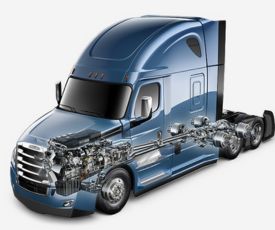
Today, I want to discuss the over-speed/under-speed function of my 2022 Freightliner Cascadia, and how it works in conjunction with Detroit Intelligent Powertrain Management (IPM). The objective of IPM is to use the momentum of the truck most efficiently to reduce fuel consumption. This is achieved by preventing unnecessary shifting, engine engagement, and braking, and precisely controlling any eCoast events.
I’m going to discuss the level of functionality that has been integrated into the driver’s menu of settings to enhance the capability of IPM. This function is accessed by pressing the menu buttons on the steering wheel control buttons. After pressing the buttons, you’ll see a screen that displays the over-speed and under-speed values.
The overspeed function controls the number of miles per hour that will be allowed over the set cruise speed before a combination of engine brake, and/or, downshifting takes place to keep the truck within the desired speed. The adjustability can be 2 to 15 mph over your cruise speed setting. It’s important to be aware of the posted speed limit concerning your selection. For example, you could have an overspeed set at 10 mph if you have a cruise speed setting at 65 mph, and are operating in a 75 mph speed zone. In addition, there’s a setting just one past the 15 mph over speed, which is called unlimited. Unlimited is not actually unlimited, as it is typically set at 3 mph over the max road speed in the parameters of the truck.
Now, let’s talk about under speed. Underspeed enhances the way the truck “crests” the top of any given grade. This feature has adjustability down to minus 10. Here’s an extreme example to explain how this works with a minus 10 setting: You’re climbing a grade with a cruise setting of 65 mph and an under-speed setting of minus 10 mph. The IPM is reading the terrain ahead. Once the system determines the hill can be crested at a speed somewhere near the minus 10 mph figure, the DT12 transmission will enter into eCoast mode allowing the truck to overcome the last part of the grade and regain speed by simply using gravity on the downward side of the grade.
To see how the system would work, I set all settings to the extreme one day while driving rolling hills with no traffic around me. The speed limit was 65 mph and I set the cruise at 55 mph. The overspeed was set at 10 mph, the underspeed at minus 10 mph. At this location, I was also losing elevation on average. Each time I reached the top of a hill and could coast over it above 40 mph, the transmission shifted early into eCoast. Additionally, if it seemed as though the truck would reach a speed above 65 mph, it would roll out of eCoast early and select a gear that would enable engine braking to hold the vehicle at the selected over-speed setting of 10 mph.
The ups and downs of all this are the ability to save fuel by maximizing the abilities of IPM. I will add that I would seldom ever set the controls to plus 15 and minus 10, as my interaction with other vehicles on the road could aggravate other motorists using the same highway. What became readily apparent was how little the engine was needed to maintain forward momentum and manage its maximum value.
In practice, I generally cruise at 65 mph, if allowed, with an over-speed value that does not exceed the speed limit and an under-speed setting of 4 mph. When in heavy traffic, I reduce the under and overspeed to prevent unnecessary interaction with other highway users.
Additionally, I will override the default setting of minus 2 mph under speed if there’s another vehicle directly behind me as I “crest” any given grade. The “cresting” feature is overridden by lightly engaging the throttle pedal while on cruise control. This is done to be polite and not aggravate my fellow drivers.
In many company trucks, it is preset to 5 over and 4 under and is non-adjustable by the driver. It’s still a useful fuel-saving technology that basically is trying to take the tops off the hills and fill in the valleys. So, whether you’re a company driver with a preset, or an owner-operator with an adjustable IPM setting, take full advantage of this fuel-saving technology for increased profitability. I encourage anyone who has this technology to experiment with different settings to maximize the benefit of this added feature.